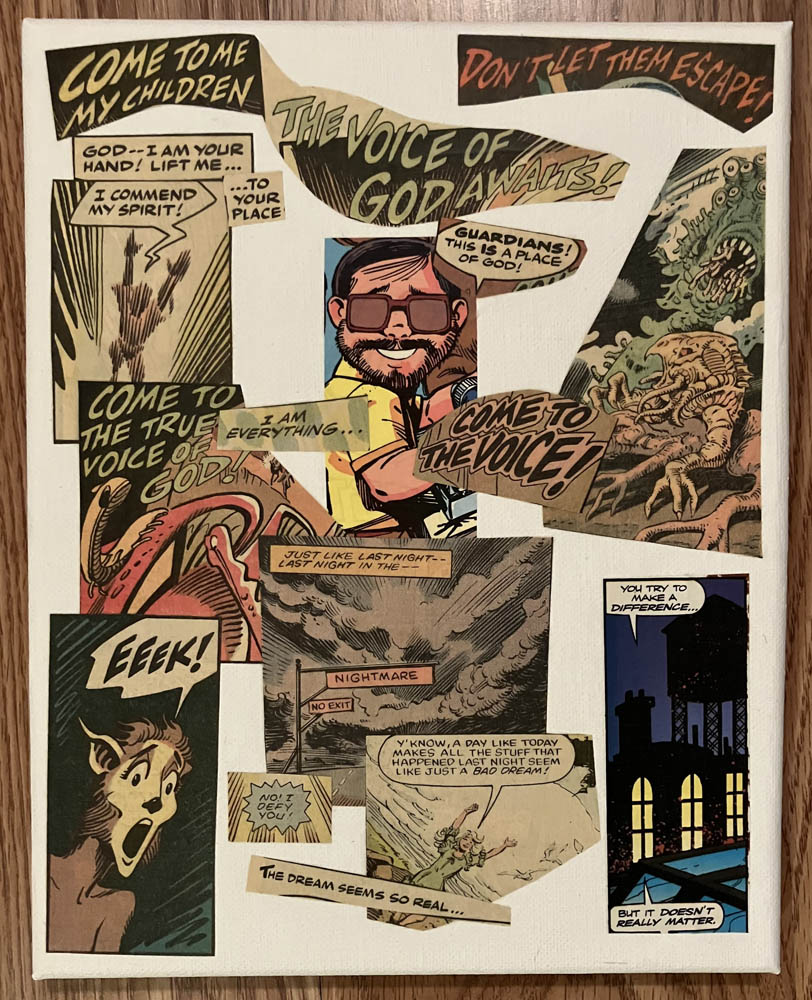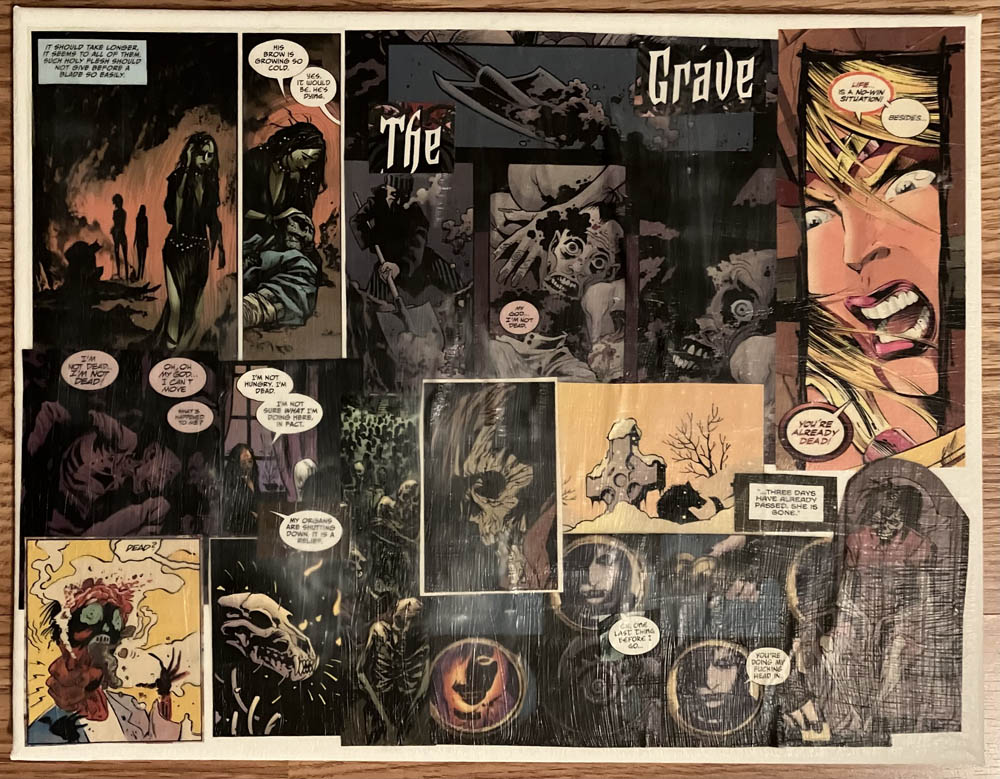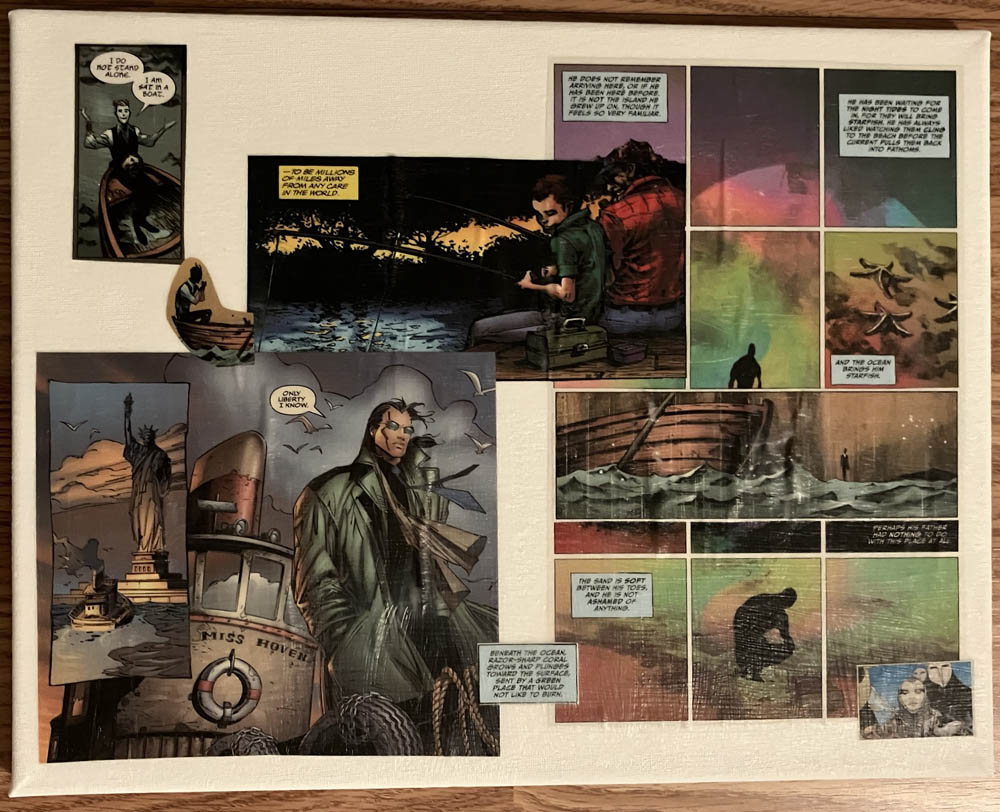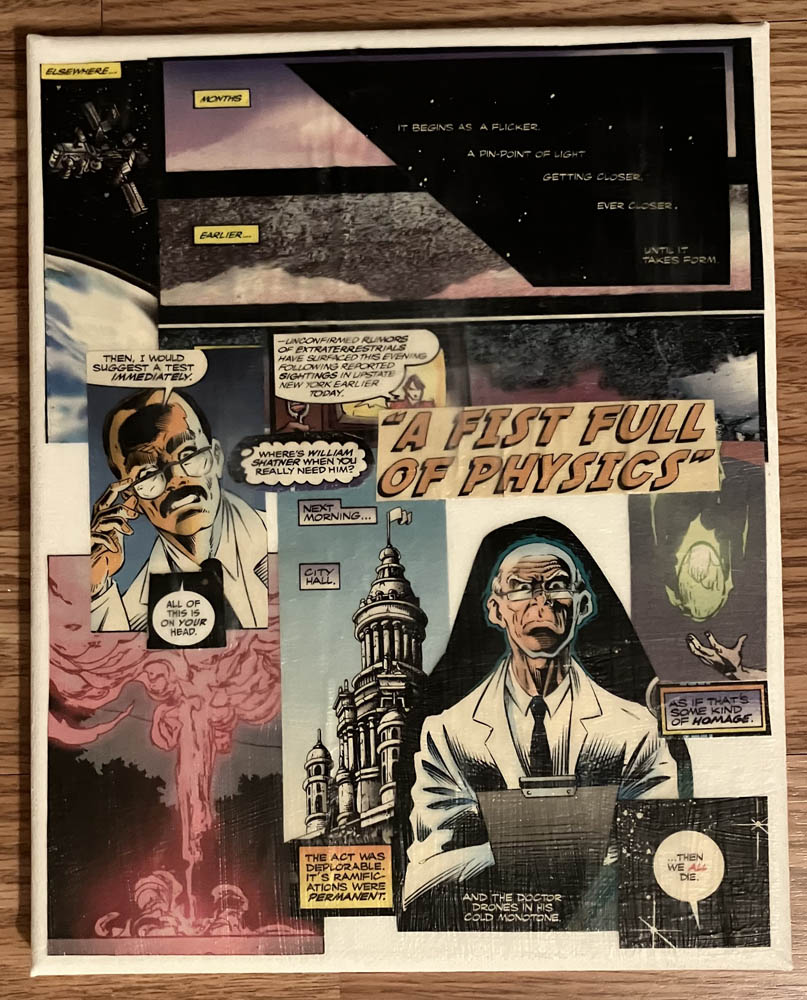
Graphic Content #30: Week of Sept. 5
More Videos
Published
2 years agoon
Welcome to the latest installment of Haunted MTL’s comic review column, Graphic Content. We’re switching things up this week, but we will get into why that is after the reviews. This week we’re covering the comics that crossed my radar the week of Sept. 5th, 2022. What horror goodness is awaiting you in local comic shops? This week we’re covering Killadelphia #24 and A Town Called Terror #6, in addition to two new titles, Shock Shop and Parasomnia: The Dreaming God.
Killadelphia #24 – “The End of All – Part VI – Time To Die”

We last reviewed Killadelphia‘s 21st issue. This week we’re catching the latest installment, issue #24, titled “The End of All – Part VI – Time To Die.” This issue follows up the declaration of war between the surprising allies of vampires, werewolves, and a witch, as blessed vampire hunters are on the approach.
As a whole, the series continues to expand and the scale of the conflict has gone beyond merely vampires to something a little more cosmic. The forces of good and evil have their soldiers and the imminent clash promises a great amount of excitement. Rodney Barnes has done a great job in this issue positioning the characters and their relationship to the conflict. We see some losses, but the conflict still has a ways to go before it resolves.
Visually, Jason Shawn Alexander presents a wonderful character-building moment through his art, depicting a character’s childhood recollection in childish, crayon-illustrated images. The double-page spreads in particular offer some highly cinematic moments as well. Luis Nct’s colors contribute significantly to the affair, with many pages in an apocalyptic red overlay.
Impressions of Killadelphia #24
Killadelphia‘s 24th issue presents some positioning of characters before the massive battle between literally forces of good and evil. What began as a series about vampires in Philly has become an exploration of the nature of humankind and monsters punctuated with stories and experiences of the sins of the past and their legacy to communities of today.
 (5 / 5)
(5 / 5)
Killadelphia is written by Rodney Barnes and illustrated by Jason Shawn Alexander. Luis Nct handles colors. You can find Killadelphia via Image Comics or your local comic shop.
Shock Shop #1

Cullen Bunn’s series Shock Shop opens with a tribute to horror hosts and the comic creeps of Creepy and Tales From the Crypt. The whole issue is comprised of anthologized tales The first is titled “Something in the Woods, in the Dark.” The first store presents a tight little body horror story intermixed with relationship drama among a circle of friends on a hike.
The second story, “Familiars,” follows a divorcee who moves into a new home that presents an initially helpful presence. The story plays on folkloric stories of elves and gnomes with a twist.
Both tales “end” at a cliffhanger, to be continued in the following issue. Yikes.
Danny Luckert’s illustrations in the first story are excellent, finding the right balance between realism and comic-book illustration. I also appreciate some of the character likenesses, which almost cast the live-action adaptation of this story we may see someday. Luckert also does a fantastic job with the colors, allowing the character line art to stand out without muddying the results. It does what Alien did, but much stronger.
Leila Leiz’s illustrations for the second story are decidedly rougher in style but thematically appropriate to the story. There is a whimsy in the art that reflects the whimsy of the associated story.
Impressions of Shock Shop #1
Shock Shop presents the horror anthology comic, like Creepshow, with a twist in that stories are not contained to a single issue. Both features in this first issue will be continued in the second issue. It’s a novel approach, and at least for the first two features it works pretty well. Specifically, each ends with a little shock, and the single-page introductions with series host Desdaemona Nimue Moreau.
With that said, an anthology series where the anthlogized tales are stretched over two (potentially more) issues may run the risk of wearing thin. With that said, this issue worked out quite well.

Shock Shop is written by Cullen Bunn and illustrated by Danny Luckert. You can find Shock Shop via Dark Horse Comics or your local comic shop.
Parasomnia: The Dreaming God #1

One writer, two books this week as we dive into Cullen Brown’s Parasomnia: The Dreaming God. The series involves the search for a missing child in a cyberpunk reality set against the real world and a dreamscape.
While Shock Shop was fun overall, Parasomnia feels dreary and is a bit of a slog to read through. The dialogue, in particular, struck me as very clichéd and took me out of the story. I felt a little bored by it. The hook of a missing child was not enough to endure the sheer amount of “things” introduced in this first issue. Cults in a cyberpunk future should be cool, but this feels tiring.
Andrea Mutti’s artwork, however, is dazzling and makes a bleak but visually interesting cyberpunk future. The usage of watercolors across the heavy black inking works out quite well and gives the setting a textured quality, as though steam and grime pervade every square inch of this future.
Impressions of Parasomnia: The Dreaming God #1
Cullen Brown’s second book that crossed my radar this week left me feeling pretty cold. There is a lot going on; the juxtaposition of contemporary and cyberpunk settings, and glimpses of a more low-tech one, feel a little much. The script tosses readers into the deep end and hopes they can pick up on what is going on. The dialogue, in particular, crosses the line between vague and expository like a tug-of-war.
Visually, this is a gorgeous comic, and Andrea Mutti deserves praise for the art. The setting isn’t anything new and her vision of cyberpunk is about what one would expect. However, through the heavy black inking and watercolor coloring cyberpunk takes on a dreamlike quality.

Parasomnia is written by Cullen Bunn and illustrated by Andrea Mutti. You can find Parasomnia via Dark Horse Comics or your local comic shop.
A Town Called Terror #6

A Town Called Terror is some parts Dark Shadows stitched together with the works of Clive Barker and a dash of the rural oddity of Twin Peaks. The comic so far has been an interesting one but a bit stilted due to the pacing.
Steve Niles only works with about 25 pages an issue on a slow-burn family drama is interesting enough but can also be frustrating. Just as frustrating is that there is a lot of information about Terror itself that would be great to have but is just hinted at. None of the characters have pulled me in, either. I am at issue #6 and have yet to feel much for anyone besides Julie, who is only now finding her way into the events after Henry was kidnapped.
Putting it another way: the comic features a deadly brawl that I felt no real investment in because six issues in, I hardly know the characters in that they are hardly characters.
Visually, the comic is fun, albeit very, very red. Symon Kudranski works from heavy photo references, but the inking style compliments them well, drenching his figures in noirish shadows. Due to the photo referenced figures, the posing can feel a bit stiff, however. The posing saps the excitement of what should have been a dynamic battle scene between a father and son.
Impressions of A Town Called Terror #6
A Town Called Terror has been a breezy read issue to issue, but it has also been a little superficial with some somewhat generic beats, almost predictably. A character will be mentioned in a conversation early on, only to make a shocking appearance by the end of the issue. The dialogue is also fairly rote with character voices blurring together. The setting itself is hinted at having all of these interesting dynamics we do not get to see as we’ve been stuck in six-installments of turgid family drama.
But hey, at least it looks pretty good.

A Town Called Terror is written by Steve Niles and illustrated by Symon Kudranski. You can find A Town Called Terror via Image Comics or your local comic shop.
Graphic Content Going Forward
Permit me, if I may, to explain the changes in this installment of the column and the plan going forward. For a long time, I have struggled with what exactly the column should be because, if you have seen previous installments, you’ll see I can be a little wordy in my assessments. It’s not necessarily bad because I have a lot to say as someone who draws and writes comics. However, it makes it hard to keep current when I realize I am pouring a few hundred words into a title or two a week if I am lucky.
So, a couple of things: the goal is to do this weekly, which means that I will try to review the latest releases as I stumble across them and as budget permits. I also may not be 100% up to date and may review a release a week or two later based on what is on my plate. My goal is to review at least three titles a week. That also means some weeks, there may not be many horror comics. In lean weeks I may dip into some older titles for fun.
If you miss my more long-form comic reviews and insights, I would suggest keeping an eye out for the next installment of Graphic Content: Just Swamp Things, which I am desperate to return to. I want to continue following the series from the earliest run up through the Alan Moore era.
But, dear reader. What do you think of the approach? Sound off in the comments, and let us know what comic sounds best to you.
David Davis is a writer, cartoonist, and educator in Southern California with an M.A. in literature and writing studies.

You may like
Horror in graphic novels
Creepy Comics Collages by Jennifer Weigel, Part 5
Published
1 year agoon
May 13, 2023
Well, you won’t get rid of me that easily… Ha ha, I lied about coming to the end and the afterlife in the Creepy Comics Collages segment, it was just an opportunity for rebirth. Besides, it’s World Collage Day! So having come into another comic book to rework, here we go again…

Creepy Comics Story 9: The Voice (of God or Reason or perhaps an homage to my ex)
“Come to me my children, the voice of God awaits!… Don’t let them escape!” Please beam me up out of this weird comic collage alternate reality. “God I am your hand! Lift me… to your place. I commend my spirit!” I want to go back to dreaming about starfish.
The computer programmer behind the scenes turns to face us and smiles. “Guardians! This is a place of God!… Come to the true voice of God!” “I am everything.” “Come to the voice!” And the horrific AI generated creatures abide by his every coded word.
Just like last night in the — signs posted for Nightmare, No Exit. The deer spirit faun screams in surprise, “Eeek!” “No! I defy you!” She returns to the form of a little girl with arms outspread to the open sky. “Y’know, a day like today makes all the stuff that happened last night seem just like a bad dream!” The dream seems so real…
Somewhere in the city, the computer programmer sits up at night in pensive monologue, “You try to make a difference… But it doesn’t really matter.”

Creepy Comics Story 10: The City (Metropolis becomes self-aware)
This segment is brought to you by Dead Artists and Talking Dinosaurs. No really, wait for it…
Woooooo Uhhhh Wooooooo Uhhhh… Wump! Uff! Wump! Uff! “She belongs to The City!” The Glenn Fry 1985 hit single looms ominously overhead as Metropolis becomes self-aware. “The City… will live!… The City… will breathe!” The City gasps for air, “Got to… breathe!… Got to… Breathe!“
Her breath is the wind… Her eyes are windows. Her heart pumps fluid through buried plumbing… “I’m The City!” Her mind is The City!
And we have a celebrity appearance by Rich Koz “Son of Svengoolie” WFLD 1973: “I take a nap for 10,000 years and look what happens… some-body builds a city!” Kerwyn chimes in, “Geez! Somebody’s been busy!” And we cut out to a scene of Svengoolie standing alongside his coffin.

Well, that’s all folks. Or is it? For now, any way… until I get more comic books… Duh duh DUHHHH…
If you want to see more art, check out more of Jennifer Weigel’s work here on Haunted MTL or on her writing, fine art, and conceptual projects websites.
Horror in graphic novels
Creepy Comics Collages by Jennifer Weigel, Part 4
Published
1 year agoon
April 30, 2023
Wow, I can’t believe you’ve stayed the course through four whole strange story posts of these creepy comics collages. But this is the final frontier, the last segment, the standing ovation as it were. So here goes…

Creepy Comics Story 7: The Grave (shallow enough for ya?)
“It should take longer, it seems to all of them. Such holy flesh should not give before a blade so easily.” “His brow is growing so cold.” “Yes it would be. He’s dying.”
“My god… I’m not dead.” Put the shovel down. “Life is a no-win situation. Besides… You’re already dead!”
“I’m not dead. I’m not dead!… Oh, Oh my god… I can’t move… What’s happened to me?” Buried alive. Or maybe not.
“Dead?” Perhaps I am actually dead. I was expecting something… I dunno… different.
“I’m not hungry, I’m dead. I’m not sure what I’m doing here, in fact.” At least I’m not a zombie. That seems a small consolation right now though. “My organs are shutting down. It is a relief.”
“Three days have already passed.” We’re just sitting here, rotting. Like Norman Bates’ Mother. At least someone was kind enough to supply a rocking chair. “Oh, one last thing before I go… You’re doing my fucking head in.”

Creepy Comics Story 8: Adrift Afterlife (why you save the best gold coins for the ferryman)
How’d we get here? “I do not stand alone. I am sat in a boat.” “.. to be millions of miles away from any care in the world.” Was that the Ferryman? “Only liberty I know.”
“He does not remember arriving here, or if he has been here before. It is not the island he grew up on, though it feels so very familiar… He has been waiting for the night tides to come in, for they will bring starfish. He has always liked watching them cling to the beach before the current pulls them back into fathoms.”
“And the ocean brings him starfish… Perhaps his father had nothing to do with this place at all.” The ferryman stands on the far shore. It makes no difference now.
“Beneath the ocean, razor-sharp coral grows and plunges towards the surface, sent by a green place that would not like to burn.” “The sand is soft between his toes and he is not ashamed of anything.” The ghosts are here, contentedly it seems.

Thank you for joining us for these creepy comics collage art stories. But here’s where we have to leave it off. Trust me, it’s best that way. Besides I’m out of creepy comics to collage with.
If you want to see more art, check out more of Jennifer Weigel’s work here on Haunted MTL or on her writing, fine art, and conceptual projects websites.
Horror in graphic novels
Creepy Comics Collages by Jennifer Weigel, Part 3
Published
1 year agoon
April 23, 2023
We’re ba-ack… Are you ready for the next creepy comics collages graphic story overload? After the last time and the intermission I wasn’t sure I’d see you again, but here we are, together again. You’d almost think we put something in the water – wink.
Now where were we? Oh yeah, the world was going to hell… or was it?

Creepy Comics Story 5: Alien Invasion (A Fist Full of Physics!!!)
“Elsewhere… months… earlier…” “It begins as a flicker pin-point of light getting closer ever closer until it takes form.” The sky is falling, damn you Chicken Little.
“…unconfirmed rumors of extraterrestrials have surfaced this evening following reported sightings in upstate New York earlier today.” There’s the news for you. Always blowing things up to increase viewership ratings.
“Then I would suggest a test immediately.” ‘K Doc, we get it; maybe there’s cause for concern. Guessing these aren’t friendlies based on intel, or that the government pissed them off. “Where’s William Shatner when you really need him?”
“Next morning… City Hall…” “A Fist Full of Physics” Blamm-o! “As if that’s some kind of homage.” It’s the end of the world as we know it, and I was feeling fine but now I’m not so sure. “All of this is on your head.” You can thank the world governments with their shoot first, ask questions later policies for that.
“The act was deplorable. It’s ramifications were permanent.” Doc looks unamused. “And the doctor drones on in his cold monotone… ‘Then we all die.’”

Creepy Comics Story 6: Werewolves (Londoners, eat your hearts out)
“Fables Werewolves… no one can hear you howl.” So now we’re elbow-deep in lycanthropy? This story just keeps getting weirder and weirder…
“… I feel so… disoriented… is this vertigo?” No, you wouldn’t be so lucky. Once bitten, twice shy. It’s The Change. Prepare yourself for the transformation.
“Hello dear.”
“What now?” Enough with the damned interruptions already, can’t you see I’m at work?!
“Shall we start a war?”
“No! No! Leave me alone! Leave me alone! No!“
“What now?”
“I know one thing.” “Never will you suffer the indignity of this animal’s touch again.” The wolf seems somewhat offended by that statement. No really. And probably rightly so.
“Maybe it’s just an excuse, a fucking cop-out for when we inevitably fuck-up our lives and hurt people… We’re not cursed, we’re rotten, or mad or…”
“I don’t deserve this!” he howls. Stop blaming the werewolves for your own human indecencies. Teacups get broken and the London werewolves get angry.
Thank you for going all in with us over this series, there’s… one… more… final… huzzah… In the meantime, check out more of Jennifer Weigel’s work here on Haunted MTL or on her writing, fine art, and conceptual projects websites.













